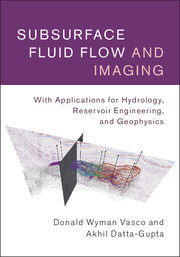 Subsurface Fluid Flow and Imaging
Subsurface Fluid Flow and Imaging Book contents
- Frontmatter
- Contents
- Preface
- Acknowledgments
- 1 The propagation of a disturbance in relation to imaging
- 2 Principles and equations governing fluid flow and deformation
- 3 Trajectory-based modeling
- 4 Equations in diffusion form
- 5 Equations governing advection and transport
- 6 Immiscible fluid flow
- 7 Coupled deformation and fluid flow
- 8 Appendix: a guide to the accompanying software
- References
- Index
- Colour plate section between pages 150 and 151
3 - Trajectory-based modeling
Published online by Cambridge University Press: 05 July 2016
- Frontmatter
- Contents
- Preface
- Acknowledgments
- 1 The propagation of a disturbance in relation to imaging
- 2 Principles and equations governing fluid flow and deformation
- 3 Trajectory-based modeling
- 4 Equations in diffusion form
- 5 Equations governing advection and transport
- 6 Immiscible fluid flow
- 7 Coupled deformation and fluid flow
- 8 Appendix: a guide to the accompanying software
- References
- Index
- Colour plate section between pages 150 and 151
Summary
Introduction
In this chapter, we develop asymptotic and trajectory-based methods for the solution of partial differential equations that arise in flow and transport through permeable media. After some background, we discuss specific forms of asymptotic solutions applicable to a wide range of problems in hydrology, geophysics, and petroleum engineering. We describe the construction of a trajectory-based solution and illustrate the procedure by an application to the wave equation. A major advantage of the asymptotic method is the partitioning of the modeling into a travel time calculation and an amplitude calculation. For example, the asymptotic method leads to the eikonal equation that governs the geometry of a propagating fluid front and the travel time of the front. Such travel times form the basis for many of the imaging and inversion techniques discussed in subsequent chapters. We conclude the chapter with an overview of a multiple scale asymptotic technique that is well-suited to problems involving spatial heterogeneity and non-linearity, two features that appear frequently in the modeling of multiphase flow through natural porous media.
Transients and propagating disturbances
As we noted in Chapter 1, our focus will be on using observations related to fluid flow and transport to better characterize the properties of a porous medium. The observations might be from an external experiment, such as a geophysical survey, attempting to image flow-related attribute changes. Alternatively, the observations might be data from tests that involve flow directly, such as the injection of a trace chemical or the monitoring of transient fluid pressure. The important point is that we will be dealing with transient disturbances that propagate through the medium. Thus, there will be a source of the disturbance, such as an injection interval. The transient will travel from the source outward into the medium, ultimately reaching an observation point where one or more instruments record the passing disturbance.
Based upon causality, there is a region ‘ahead’ of the propagating front, representing the undisturbed volume and a region ‘behind’ the front through which the disturbance has already propagated. We assume that the surface separating the undisturbed and disturbed volumes may be characterized by an equation of the form
defining its spatial position at time t (Whitham, 1974, p. 236). As long as the front varies with time, so that
we can solve the equation S(x, t) = 0 for t as a function of the spatial coordinates, at least locally.
- Type
- Chapter
- Information
- Subsurface Fluid Flow and ImagingWith Applications for Hydrology, Reservoir Engineering, and Geophysics, pp. 101 - 130Publisher: Cambridge University PressPrint publication year: 2016


